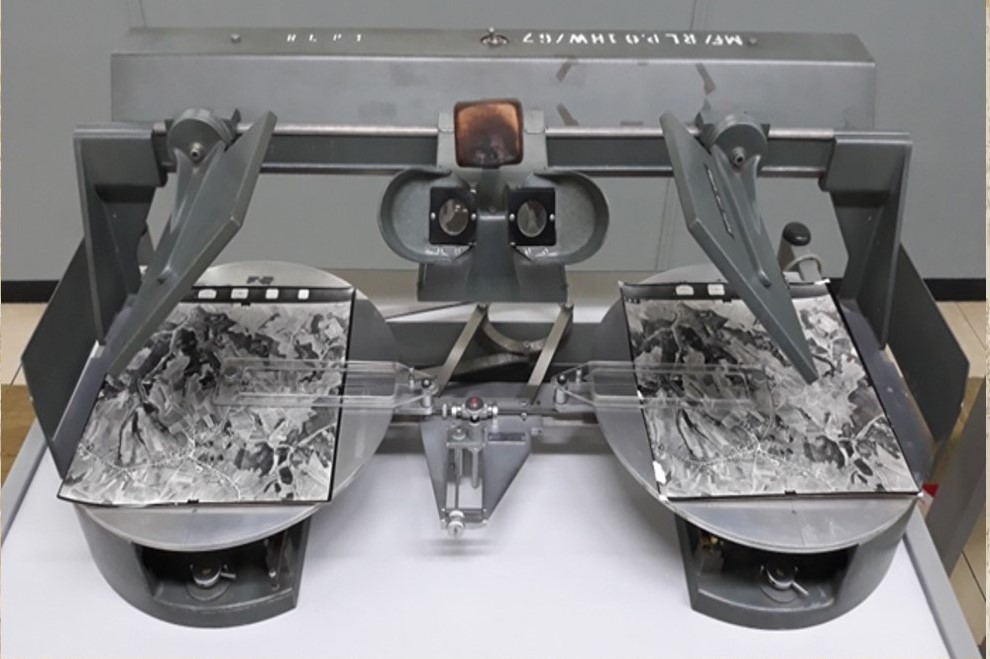artifact
RADIAL LINE PLOTTER
This Radial Plotter was used at the Department of Photogrammetry, Faculty of Surveying during the 1960s to 1990s to produce topographic maps using a photogrammetry method. The students were exposed to mapping concepts and topographic mapping procedures using photographs as the main data source. This tool was used as the basic for photogrammetry principles and procedures in laboratories and for Bachelor’s Degree Project (formerly known as Special Technical Project) of students specialising in photogrammetry. Photographs with overlapped images were attached to this device and the creation of 3D images were displayed through a telescope. With the aid of a floating point, the shape and height of the surface could be seen and this allowed the contours of the terrain which were consistent with the scale map be produced fast and accurately. The photogrammetry equipment changes as technology progresses. As a result, at the end of the 1990s, this tool was no longer in use after the Faculty relied heavily on stereo plotter and digital plotter which were controlled by a computer.
PROCESS CAMERA
The ‘Process Camera’ was manufactured by Hunter Penrose Ltd., a company which was based in the United Kingdom where thousands of these devices were sold worldwide in 1890 until 1962. This camera which was a gift from the Department of Survey and Mapping Malaysia (JUPEM) was used since the British colonial. This initial model was fully mechanical and was used to facilitate students in understanding the principles and procedures of photography production. This KLIMCH ‘horizontal process camera’ was used at the Cartography Department, Faculty of Surveying during the early 1980s until the late 1990s. The students who undertook land surveying course drew map sketches on papers or tracing papers using technical pens to produce maps and graphics in a conventional method. The final drawing or manuscript was considered as a scientific document which could be used for various application specifically in the planning and development of land or landfill. The result of the sketch was displayed onto a specific location which was the focal point of the camera lens. Plates and films containing terracotta contour images were processed to produce black-and-white maps or coloured maps. Printed topographic maps were treated as ‘CONFIDENTAL’ and ‘LIMITED’ and used only for teaching and learning purposes in the Faculty. The application of this camera was ceased in early 2004 due to the advent of digital technology.
CARD CATALOGUE
From the 1970s to the late 1980s, cards catalogue were the main source of reference used by the library staff and students to search for materials in UTM Library. Each library collection information such as the title, author, publication information and physical description was recorded to a 3×5-inch card catalogue and organised by main search source based on the title, author and subject for easier retrieval of items on the shelves. The cards catalogue were then arranged and stored in alphabetical order within each drawer of the card catalogue cabinet and separated by the main search source as specified. The card sorter was used to isolate each card catalogue in an alphabetical order and the main search source. The use of the card catalogue was replaced by the first computerised cataloguing system known as BERLIAN which operated from 1987 until 1990. This system made it easier to search for library materials electronically. The use of BERLIAN systems has opened a new dimension to the long history of catalogue cards application in the library services over the years from 1973 to 1987. BERLIAN has taken over the functions of the card catalogue and was considered as a turning point for future system development.
INFOLAN TERMINAL
The INFOLAN terminal provides general online access to the collection of materials in UTM Library. It was used by staff and students to search for materials in UTM Library from 1991 to 2000 after the use of the BERLIAN system in 1987-1990. Material searches use keywords for the main source of searches based on the title, author, subject, and material call number. INFOLAN utilises Dynix Automated Library system which contains five main modules namely Acquisition, Cataloging, Serial, Circulation and Online Public Catalog used by the library staff to meet the needs of the main work processes at the time. UTM Library INFOLAN system was launched by Al-Marhum Sultan Iskandar ibni Al-Marhum Sultan Ismail on April 16, 1992.
KERIS GANJA SEIRAS MELELA
His Majesty Yang di-Pertuan Agong the Sixth, graciously bestowed the keris named “Keris Ganja Seiras Melela” to the University on Monday, November 28, 1977. The use of this keris as a symbol of the University’s authority is in line with the nation’s aspiration to foster national culture. This particular artifact is one of the exhibits from Tan Sri Datuk Dr. Ahmad Zaharuddin Idrus, the former Vice-Chancellor of UTM who served from 1 June 1994 to 5 January 2001. He was presented with this keris by UTM as a token of appreciation for his dedicated service as Vice-Chancellor.

BARCODE PRINTER – TOSHIBA TEC CORPORATION
The Toshiba TEC Corporation barcode printer was used in the Acquisition Unit of the UTM Library around the 1990s to early 2000s to print barcode labels for new materials such as books and theses. These barcodes facilitated the recording, borrowing, and tracking processes within the library system. The printer helped enhance the efficiency of collection management and ensured that each item was accurately identified and well-organized.





